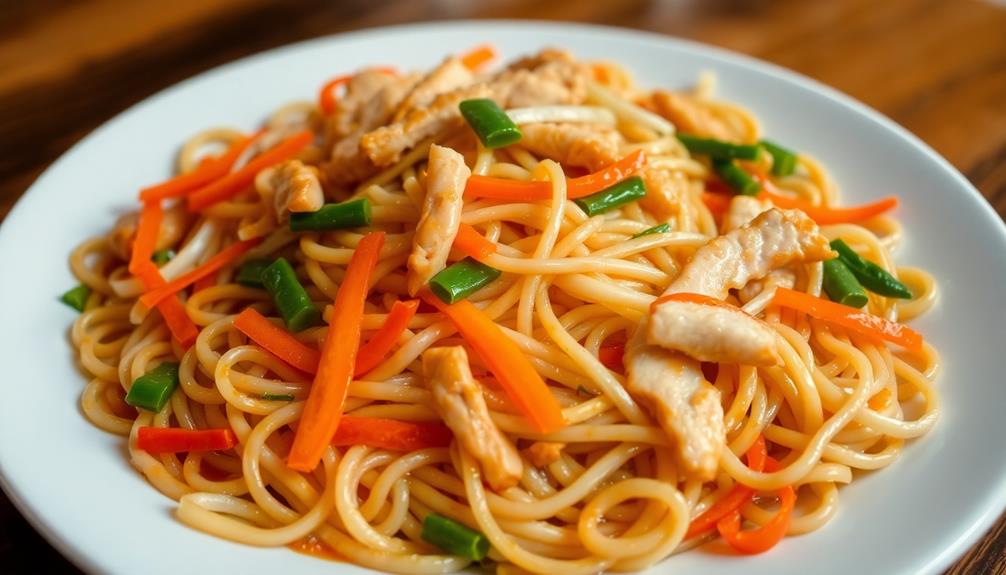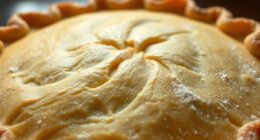Butternut squash casserole is a beloved autumn dish that's been a staple in American cuisine for centuries, with roots dating back to Native American tribes like the Iroquois and Seminole. It features a creamy blend of tender squash, rich cream, and fragrant spices, often topped with a crispy golden-brown crust of cheese and breadcrumbs. This comforting casserole makes for a delightful side dish or vegetarian main course, pairing perfectly with roasted meats or as the star of the show at festive gatherings. To discover more about the history and preparation of this seasonal favorite, continue reading.
Key Takeaways
- Butternut squash casserole is a creamy, comforting dish featuring the sweet and nutritious winter squash, often paired with cheese, herbs, and a crunchy topping.
- The dish has a long history, with Native American tribes and European settlers incorporating the versatile squash into their cuisines over centuries.
- The preparation involves roasting cubed butternut squash, combining it with a creamy sauce, and baking it with optional add-ins like cheese, pecans, and breadcrumbs.
- Butternut squash casserole is a popular seasonal favorite, suitable as a side dish or a main vegetarian option, often enjoyed during autumn gatherings and celebrations.
- The dish has a balanced flavor profile, blending the natural sweetness of butternut squash with savory and crunchy elements, making it a crowd-pleasing choice.
History
Butternut squash, a versatile member of the winter squash family, has long been a staple in American cuisine. This sweet, nutty-flavored vegetable has been cultivated in the Americas for centuries, with evidence of its use dating back to as early as 10,000 BC.
Native American tribes, such as the Iroquois and Seminole, were among the first to incorporate butternut squash into their diets, utilizing the entire plant – from the seeds to the flesh.
As European settlers arrived in the New World, they quickly adopted this vibrant orange squash, finding creative ways to incorporate it into their cooking.
Today, butternut squash remains a beloved ingredient, appearing in a wide range of dishes, from roasted side dishes to creamy soups and decadent casseroles. Many people also enjoy incorporating butternut squash into pasta dishes or using it as a filling for ravioli. One classic way to highlight the rich, sweet flavor of butternut squash is to make a creamy butternut squash soup. This comforting dish is perfect for cold winter nights and is often garnished with a dollop of sour cream or a sprinkle of crispy bacon for added flavor.
Its popularity has spread globally, making it a staple in many culinary traditions around the world.
Recipe
Butternut squash is a versatile and delectable winter vegetable that lends itself perfectly to a cozy and comforting casserole. This dish is a wonderful way to showcase the natural sweetness and creaminess of butternut squash, complemented by savory seasonings and a crispy topping.
Preparing this casserole is a straightforward process that yields a satisfying and impressive meal. The combination of creamy squash, flavorful herbs, and a golden-brown crust makes this dish a crowd-pleasing favorite.
Ingredients:
- 1 large butternut squash, peeled, seeded, and cubed (approximately 4 cups)
- 1 cup heavy cream
- 1/2 cup milk
- 2 eggs
- 1 teaspoon salt
- 1/2 teaspoon black pepper
- 1/2 teaspoon dried thyme
- 1/2 teaspoon dried sage
- 1 cup shredded cheddar cheese
- 1/2 cup panko breadcrumbs
- 2 tablespoons melted butter
Instructions:
Preheat the oven to 375°F (190°C). Grease a 9×13-inch baking dish.
In a large bowl, combine the cubed butternut squash, heavy cream, milk, eggs, salt, black pepper, thyme, and sage. Mix well until fully incorporated.
Pour the mixture into the prepared baking dish. Top with the shredded cheddar cheese, followed by the panko breadcrumbs and melted butter.
Bake for 45-55 minutes, or until the squash is tender and the top is golden brown.
When preparing this dish, be sure to peel and cube the butternut squash thoroughly to ensure even cooking. The combination of creamy squash, flavorful herbs, and crispy topping makes this casserole a truly comforting and delicious meal. Enjoy!
Cooking Steps
Preheat your oven to 400 degrees.
Peel and chop your butternut squash into bite-sized pieces.
Mix the squash with your desired seasonings until well coated.
Bake the casserole until the squash is tender, then continue baking until the top is golden brown.
Step 1. Preheat Oven to 400 Degrees
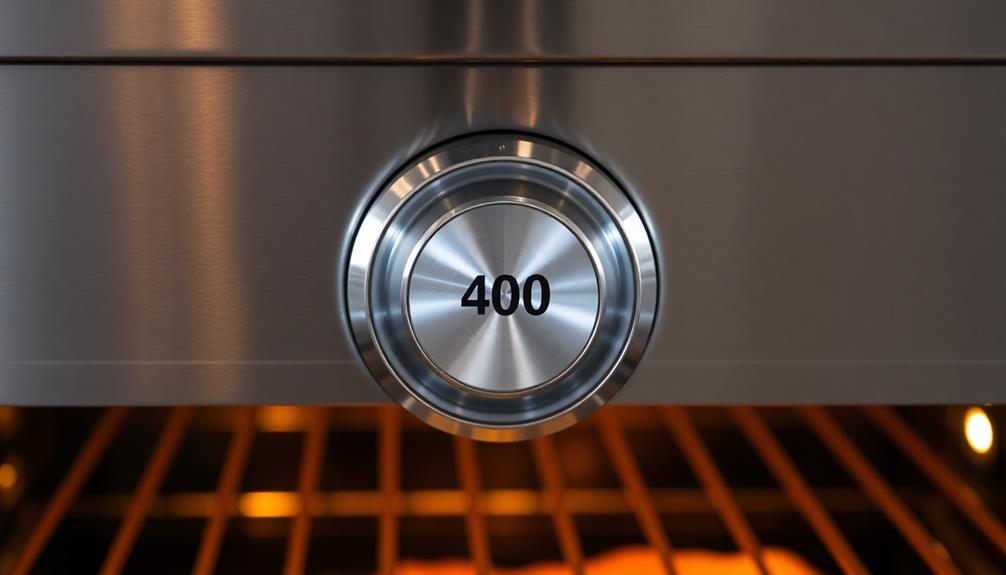
First, you'll want to set your oven temperature to 400 degrees. This high heat is essential for roasting the butternut squash to perfection, unlocking its natural sweetness and developing a delightful caramelized crust.
Allowing your oven to fully preheat is crucial – you'll know it's ready when the temperature indicator light goes off or your oven beeps to signal it has reached the desired setting.
Once your oven is nice and hot, you can go ahead and slide in the prepared casserole dish. This high heat will ensure the squash cooks through evenly and develops that sought-after golden-brown exterior.
Depending on your oven, the casserole may need 30-45 minutes to fully bake. Be sure to keep an eye on it, checking occasionally to prevent overbrowning.
When the squash is fork-tender and the top is nicely caramelized, you'll know it's ready to come out of the oven, filling your kitchen with the comforting aroma of fall.
Step 2. Peel and Chop Butternut Squash

Begin by peeling the butternut squash. Use a sharp vegetable peeler to remove the thick, tough outer skin, taking care to remove all the green patches. This will ensure your squash cubes have a smooth, uniform appearance once chopped.
Next, cut the squash in half lengthwise. Scoop out the seeds and stringy pulp from the center using a spoon. Discard the seeds and pulp, or save them to roast later as a tasty snack.
Place the butternut squash halves cut-side down on a stable surface. Using a large, sharp knife, carefully slice the squash into 1-inch thick half-moons.
Then, cut each half-moon into 1-inch cubes. The goal is to achieve evenly sized pieces that will cook at the same rate in the casserole.
Once peeled, seeded, and chopped, your butternut squash is ready to be added to the casserole dish and baked to tender, golden perfection.
Step 3. Mix Squash With Seasonings
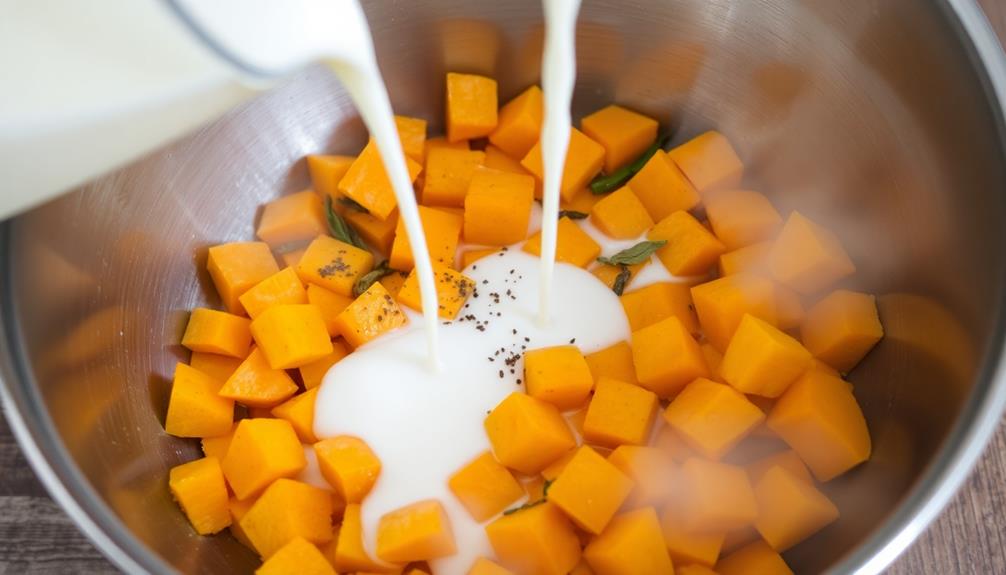
With the butternut squash now prepped and ready to go, it's time to mix it with the savory seasonings. In a large bowl, combine the chopped squash with olive oil, salt, pepper, and any other desired spices. The olive oil will help the seasonings adhere to the vegetables, while the salt and pepper provide a classic flavor profile.
You can also add in:
- Dried thyme or rosemary for an earthy touch
- Garlic powder or minced fresh garlic for a pungent aroma
- Paprika or chili powder for a hint of smokiness
- Onion powder to complement the natural sweetness of the squash
Gently toss the ingredients together until the squash is evenly coated. This step infuses the cubes with mouthwatering flavor, setting the stage for the casserole's final bake.
Take a moment to breathe in the aromatic blend – the scents of autumn are about to fill your kitchen.
Step 4. Bake Casserole Until Tender

Preheat your oven to 375°F (190°C). Grease a 9×13 inch baking dish and set it aside.
In the prepared dish, arrange the cooked butternut squash in an even layer. Sprinkle the top evenly with the seasoned breadcrumb mixture you created earlier.
Bake the casserole for 30-35 minutes, or until the top is golden brown and the squash is fork-tender. The aroma will fill your kitchen as the squash bakes to perfection.
Midway through the baking time, you can gently stir the casserole to ensure even cooking.
Once the casserole is done, remove it from the oven and let it cool for a few minutes before serving. The squash should be soft and the breadcrumbs crisp.
Serve the butternut squash casserole hot, garnished with a sprinkle of fresh parsley or thyme, if desired. Enjoy this comforting and flavorful dish as a side or as a main course.
Step 5. Finish Baking Until Golden Brown
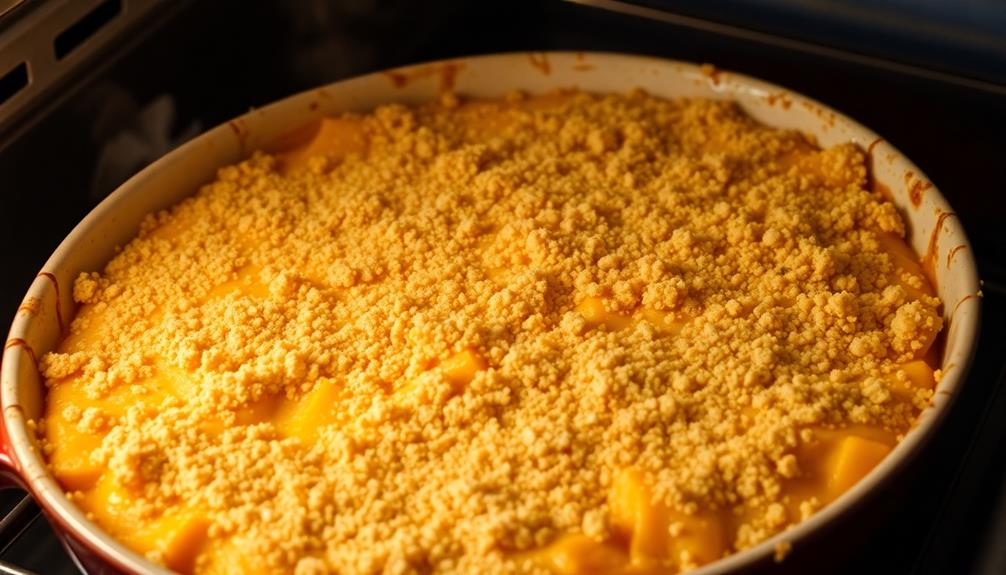
Preheat your oven to 375°F (190°C) if you haven't already. Once the oven is hot, carefully transfer the partially baked casserole back into the oven.
Let it continue baking for an additional 15-20 minutes, or until the top is golden brown and the squash is completely tender when pierced with a fork.
Keep a close eye on the casserole during this final baking phase. You'll want to avoid over-browning the top, so you may need to cover it loosely with aluminum foil if it starts to brown too quickly.
The goal is to achieve a beautiful, even golden-brown crust that complements the tender, flavorful squash below.
When the casserole is done, remove it from the oven and let it cool for a few minutes before serving. This allows the flavors to meld and the casserole to set up a bit.
Serve the butternut squash casserole hot, garnished with a sprinkle of fresh herbs or a dollop of sour cream, if desired. Enjoy!
Final Thoughts
This casserole is a satisfying and comforting dish that's perfect for autumn gatherings. The combination of the sweet and savory butternut squash, the creamy cheese sauce, and the crunchy topping creates a delightful contrast in both flavor and texture.
As you take a bite, the soft, velvety squash melts in your mouth, while the toasted breadcrumbs and pecans provide a delightful crunch.
The ease of preparation is another standout feature of this recipe. With just a few simple steps, you can create a beautiful and impressive dish that's sure to impress your family and friends.
Whether you're serving it as a side dish or as the main event, this butternut squash casserole is a true crowd-pleaser.
As the weather turns cooler, this comforting casserole is the perfect way to celebrate the flavors of the season. Enjoy it alongside roasted meats, or savor it on its own for a satisfying vegetarian meal.
No matter how you choose to serve it, this casserole is sure to become a new autumn favorite.
Frequently Asked Questions
Can Butternut Squash Casserole Be Made in Advance?
Yes, you can make this dish in advance. Simply prepare the casserole, cover, and refrigerate it until you're ready to bake it. It'll save you time and ensure a flavorful, hassle-free meal.
What Are Some Alternative Toppings for the Casserole?
You can easily top the casserole with a variety of ingredients. Try sautéed mushrooms, caramelized onions, crumbled feta cheese, or a crunchy topping like panko breadcrumbs or crushed nuts for added texture and flavor.
Can the Recipe Be Modified for Dietary Restrictions?
Absolutely! You can easily modify the recipe to accommodate dietary restrictions. Consider using dairy-free or gluten-free ingredients, adjusting seasonings, and exploring alternative proteins or vegetables to create a customized, delicious dish that meets your specific dietary needs.
How Long Does the Casserole Typically Take to Bake?
Typically, the casserole will take around 45-60 minutes to bake, depending on the size of the dish and your oven temperature. Keep an eye on it and adjust the baking time as needed to ensure it's fully cooked through.
Can Leftovers Be Frozen for Later Use?
Absolutely, you can freeze the leftovers for later use. Simply store them in an airtight container and they'll keep for 2-3 months. When you're ready to enjoy them, just thaw and reheat in the oven or microwave.

